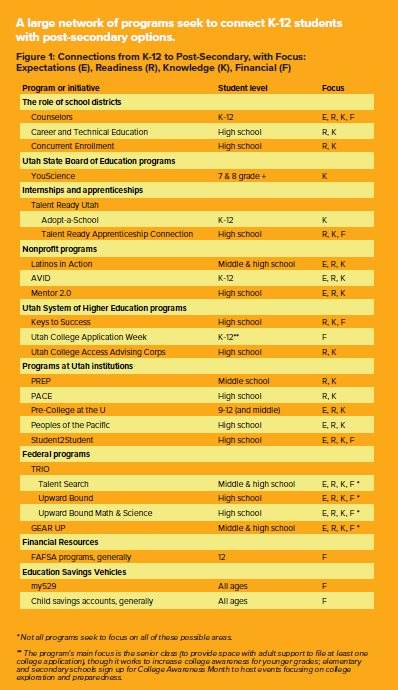When looking beyond high school, some Utah students face low expectations, a shortfall in post-secondary readiness, a lack of knowledge around post-secondary options and financial challenges. This report, Broadening Horizons: Clearing an Early Path to Post-Secondary Success, not only explores these challenges, but also seeks to reveal the network of supports that can help smooth the transition out of high school, broadening the educational horizons of Utah youth.
Broadening Horizons is the second report in the Utah Educational Attainment Series. The first report, Beating the Odds: Post-Secondary Success for Adult, First-Generation and Lower-Income Students, focused on what post-secondary institutions can do to promote both student retention and completion of certificates and degrees. The new report, by contrast, focuses on the K-12 arena.
Among the findings of the new report:
- Broadening educational horizons begins at home. Setting high expectations in the household and a student’s wider community can have significant impacts on educational attainment.
- Early basic attainment is important for students. Students who are not reading on level by the end of third grade are far less likely than peers to pursue post-secondary education.
- Schools may be able to bridge expectation and attainment gaps by providing challenging curricula, creating a college prep environment for all students, promoting the development of critical thinking skills and emphasizing student engagement.
- Intentional exposure to post-secondary education and career paths should begin in elementary school through mentorship, field trips, career days and other activities.
- Students who fill out federal student loan and grant applications are far more likely to continue their education past high school than those who do not.
- Utah currently ranks 50th in the United States for its financial application completion rates. This suggests that stakeholders should create programming to strongly incentivize high school students to apply as a matter of course.
- Studies suggest a significant tie between higher numbers of school counselors and greater post-secondary attainment. During the 2019-20 school year, Utah’s ratio of students to school counselors was 547:1 – well above the national average of 424:1 and the recommended ratio of 250:1 – though Utah is on the path to improving its ratio.
- Providing students with good information on post-secondary options can significantly increase their likelihood of enrollment, and even success, in post-secondary institutions.
- Savings – even just a small amount of college savings for lower-income students – correlates with a much higher likelihood of graduating from college. To that end, Utah’s my529 is currently helping more than 113,500 Utahns save an average of $14,000 each for post-secondary education.
Special thanks to Union Pacific and the Brent and Bonnie Jean Beesley Foundation for providing project-based support.



